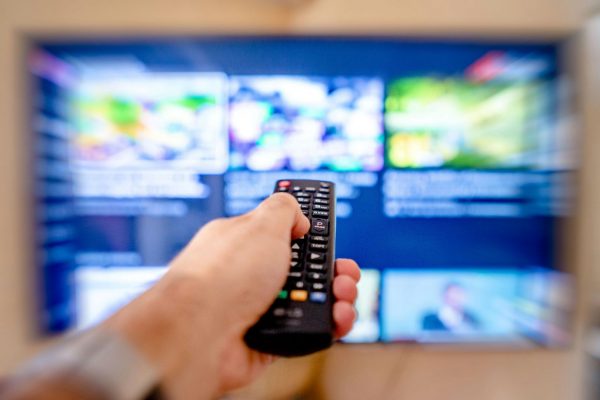With so many streaming services at our fingertips, it’s easy to get trapped into a binge-watching marathon. And that’s risky business.
When people spend hours at a time sitting still while watching TV, they are just asking for trouble. I even tell people that “sitting is the new smoking,” because the health effects are similar.
Blood flow slows down and your blood becomes more viscous. This puts you at greater risk of developing blood clots. Because blood tends to pool in your legs and feet, that’s where you’re going to get the clots.
I compare it to “economy-class syndrome.” That’s what we call clotting problems that occur in airline passengers after several hours of flight.
The problem is that a clot can break loose and travel to your heart, lungs or brain where it can get stuck and block blood flow.
You might think that as long as you’re active when you aren’t sitting around, that you’ll offset the risk. But even people who regularly engage moderate to vigorous physical activity face an increased risk of a clot. It simply doesn’t offset the damage caused by long periods of sitting.
An Easy Way to Offset the Risks of Sitting
Research finds that normal blood flow to the legs becomes significantly impaired within an hour of sitting, and continues to decline over the next several hours. But guess what?
When people walk for just 10 minutes after a prolonged period of sitting, it restores normal blood flow.
This is one of the key reasons that I recommend people to take a walk up and down the aisle every half hour or so when flying on a plane. But the same rule applies when you’re sitting at home – whether you are reading, watching TV, working at your computer or anything else that causes you to sit for long periods of time.
But taking a brief walk isn’t just better for blood flow. A study from Medicine and Science in Sports and Exercise finds that taking a light walk every half hour also has an effect on blood sugar, blood pressure and mental health.
The study tested the results of walking one minute after 30 minutes of sitting and one minute after sitting for 60 minutes; or walking for five minutes after every 30 minutes of sitting and five minutes after every hour.
The winning regimen was to walk five minutes after every 30 minutes of sitting.
It reduced after meal blood sugar spikes by nearly 60%, and reduced blood pressure by four to five points. Additionally, all of the walking routines (except walking one minute every hour) improved mood and reduced fatigue.
That’s a lot of health benefits in a very short amount of time.
What are the Symptoms of a Blood Clot?
Symptoms of a blood clot might not be apparent. And when they do occur, they can easily be mistaken for something else.
Some of the most common symptoms include swelling, discoloration in the area, warm skin, tenderness and fluid build-up in the affected limb.
If a clot reaches the lungs, heart or brain, it could result in a pulmonary embolism, heart attack or stroke. If you experience facial drooping, difficulty speaking, weakness in one arm or leg, sudden shortness of breath or chest pain that extends to the neck, arms, jaw or back, call 911 immediately.
In the meantime, prevention is always your best strategy.
Stay active! If you feel link binge-watching TV, get up and walk around every twenty to thirty minutes. Eat a healthy plant-based diet. Stay hydrated. Take your antifibrinolytic enzyme (nattokinase, lumbrokinase or serrapeptase). And don’t forget your fish oil and curcumin.
SOURCES:
Kunutsor SK, Dey RS, Laukkanen JA. Television viewing and venous thrombo-embolism: a systematic review and meta-analysis. Eur J Prev Cardiol. 2022 Jan 20:zwab220.
Kubota Y, Cushman M, Zakai N, Rosamond WD, Folsom AR. TV viewing and incident venous thromboembolism: the Atherosclerotic Risk in Communities Study. J Thromb Thrombolysis. 2018 Apr;45(3):353-359.
Thosar SS, Bielko SL, Mather KJ, Johnston JD, Wallace JP. Effect of prolonged sitting and breaks in sitting time on endothelial function. Med Sci Sports Exerc. 2015 Apr;47(4):843-9.
Weng Y, Yao J, Sparks S, Wang KY. Nattokinase: An Oral Antithrombotic Agent for the Prevention of Cardiovascular Disease. Int J Mol Sci. 2017;18(3):523
Sharma C, Jha NK, Meeran MFN, Patil CR, Goyal SN, Ojha S. Serratiopeptidase, A Serine Protease Anti-Inflammatory, Fibrinolytic, and Mucolytic Drug, Can Be a Useful Adjuvant for Management in COVID-19. Front Pharmacol. 2021;12:603997.
Golanski J, Szymanska P, Rozalski M. Effects of Omega-3 Polyunsaturated Fatty Acids and Their Metabolites on Haemostasis-Current Perspectives in Cardiovascular Disease. Int J Mol Sci. 2021 Feb 27;22(5):2394.
Kim DC, Ku SK, Bae JS. Anticoagulant activities of curcumin and its derivative. BMB Rep. 2012 Apr;45(4):221-6.
Keihanian F, Saeidinia A, Bagheri RK, Johnston TP, Sahebkar A. Curcumin, hemostasis, thrombosis, and coagulation. J Cell Physiol. 2018 Jun;233(6):4497-4511.



